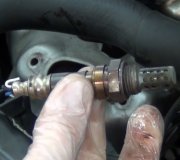First you have to understand you're buying a car made by one of the world's least customer-friendly manufacturers. Parts are going to be very expensive, and almost all repairs will have to go back to the dealer. BMW does not release paint codes or service information. When someone is selling a car without fixing known problems first, you can be sure it's going to cost you more than you expect, and more than they're letting on. If solving a problem was as easy as screwing in a couple of parts, why didn't they do it?
Second, you have to wonder how it was determined two oxygen sensors failed at the same time. If someone read the diagnostic fault codes and found one related to a sensor, those codes never say to replace parts or that they're defective. They only indicate the circuit or system that needs further diagnosis, or the unacceptable operating condition. There's about a dozen fault codes related to O2 sensors, and over half of them are the result of a defective condition being reported by a properly-working sensor. Changing the sensor for one of those codes doesn't fix the cause of the problem. A sensor referenced in a code is only the cause of that code about half of the time. You also have to test the wiring to be sure a broken wire or corroded connector terminal isn't the cause of the problem.
As far as ignoring a problem, two things must be considered. '95 and older cars only have an oxygen sensor in front of the catalytic converter. Its readings are used by the Engine Computer to fine tune the fuel / air mixture going into the engine. Without good readings to go by, you're going to get too much or too little fuel. Too little fuel will cause a stumble or hesitation. To avoid that, the factory-programmed default values for fuel metering typically err on the rich side. The engine will run fine but a lot of wasted raw fuel will be going out the tail pipe. If that gets bad enough, the catalyst in the converters can overheat and melt causing a lot more trouble, and very expensive repairs. At the very least, you'll be spending more money of fuel than necessary.
Finally, any fault code related to something that could adversely affect emissions must turn on the Check Engine light. To set a fault code there is always a long list of conditions that must be met, and one of those is that certain other codes can't already be set. The computer compares various sensor readings and operating conditions to each other to determine when something is wrong. As an example, it knows that when the engine has been off at least six hours, the coolant temperature sensor and the intake air temperature sensor had better be reading the same temperature. When a fault code is set for one of them, the computer knows it can't rely on its reading for comparing to other sensors, so it suspends some of those tests. If a failure occurs with that second sensor, it can seriously affect engine performance, but you'll never know the cause if an additional code doesn't set to indicate which circuit has the problem. If the Check Engine light is already on when you're driving, you'll never know if a second code sets. That second problem can be a very minor one that will turn into an expensive one if it is ignored.
This also leads to a common source of frustration BY and ABOUT mechanics. When the first problem is ignored for a long time, like you're asking about doing here, that gives a second, totally unrelated problem plenty of time to develop. If the computer has suspended some self-tests because of the first problem, when your mechanic reads the fault codes so he can give you a repair estimate, he will have no way of knowing about the second problem. His goal is to fix the problem right the first time, but in this case, with no way of knowing about the second problem, he can only tell you about the first one that has the fault code. It isn't until after that first problem is fixed that the computer will resume all of the tests it runs, and that's when it detects the second problem and turns the Check Engine light on again. You incorrectly assume the mechanic didn't diagnose or repair the problem properly, and the mechanic is frustrated because he has to start the diagnosis all over and tell you more parts or services are needed. They hate having to do that.
A lot of those self-tests that resume after repairing the first problem don't run right away. That means the Check Engine light is likely to turn on again hours or days after leaving the repair shop. This happens most commonly to people who tend to ignore problems for a long time. That's why the same people keep coming back angry and they assume the mechanic is incompetent. If they run to a different shop, and the new problem gets fixed, they blame the first mechanic for not fixing their car right the first time. Most of that can be avoided when you take care of a problem right away.
Sunday, January 26th, 2014 AT 10:03 AM



